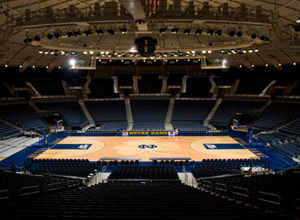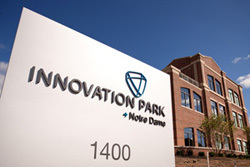
Two recently completed buildings at the University of Notre Dame have been LEED certified by the United States Green Building Council.
Purcell Pavilion at the Joyce Center received LEED Gold certification for the following sustainable design features:
- More than 20 percent of the construction materials in the building were manufactured and harvested regionally (within 500 miles) of the project;
- Rapidly renewable materials, such as cork, were used for the floors;
- The roof membrane is a highly reflective white, which reflects the heat in the summer and reduces the cooling load;
- The building’s energy system was designed to be 21 percent more efficient than a baseline model depicted by a conventional design approach;
- 1,246 tons (83.2 percent of total) of construction waste was diverted from the landfill;
- The building uses low flow urinals, faucets and shower heads, and dual flush low-flow toilets;
- Low-emitting materials are used throughout as adhesive and sealants for the floors, paints and coatings, and carpet;
- 16 percent of the building materials used consisted of post-consumer and pre-consumer recycled content, including the structural steel and reinforcement, concrete, metal studs, insulation, aluminum window framing, gypsum wallboard, spray fireproofing, terrazzo, toilet partitions and ceiling tile.

Innovation Park at Notre Dame has achieved LEED Silver certification for these features:
- Bike racks and a shower are provided to promote alternative transportation methods to the building;
- The use of large windows allows for most of the interior spaces to receive natural daylight, which in turn results in a reduced need for the use of interior lights. They also allow 90 percent of the interior spaces to have views to the exterior;
- Parking spaces are reserved for low emitting/fuel efficient vehicles and for carpool vehicles;
- Energy efficiency measures include an improved thermal envelope, high efficiency glass, reduced power lighting density, and occupancy sensors to control interior lighting;
- More than 60 percent of the construction materials in the building were manufactured and harvested regionally (within 500 miles) of the project;
- 100 percent of the wood used in the project is FSC-certified, ensuring that all the wood products used were grown and harvested in a safe and sustainable manner;
- 256 tons of construction waste was diverted from landfills;
- The irrigation system utilizes new technology by using a weather station, rain gauge, special controllers for spray heads, and drip irrigation in planting beds for an overall savings of 108,450 gallons of water a year;
- 34 percent of the building materials were made from recycled content;
- The roof membrane is white, which reflects the heat in the summer, which in turn reduces the cooling load;
- The cleaning products and methods used in the building are environmentally-friendly.
Notre Dame now has five LEED-certified buildings – four Gold and one Silver. The Carole Sandner Hall and Compton Family Center, two major projects currently under construction on campus, are both seeking LEED certification after completion in May and October, respectively.
Contact: Doug Marsh, associate vice president and University architect, dmarsh@nd.edu